El Bueno, El Feo y El Malo
Capturing the good, the bad and the ugly of lesser-known Spain and now Southeast Asia
My favorite destination in South East Asia
1. The other side of Myanmar (part 2)
Just back from some exploring around Krabi town (number 3 on this list), but first the second half of my Myanmar journey.
After the infamous night out in Bago (see last post) we woke up way too late for the morning bus. Luckily our weird rule for this holiday was we could never use the same way of transport twice, so we asked the cousin of the guesthouse-owner to drive us to next stop Hpa-an, and we hadn´t done that before.
After a 4-hour ride we arrived late in the afternoon to find the only guesthouse in the lonely planet full, but after walking around a bit we found a small hotel run by a Chinese woman, who gave us the advice to cross the river and climb a small but steep hill to see the sunset…

(1/280, f5.6, iso400, 17mm)
This view was on the other side of the river from Hpa-an with sacred Mt. Swegabin in the back. A fisherman took us there, but the last boat was going back at 18h, just before sunset. So after some explaining (hardly anyone on this travel spoke English) we got him to come back at 19h, which was a smart move as we met some other backpackers up there who had to go back early and missed a beautiful sunset view.
Like all hilltops around Myanmar this was crowned by a pagoda and halfway up the climb lived a friendly monk with his dogs.
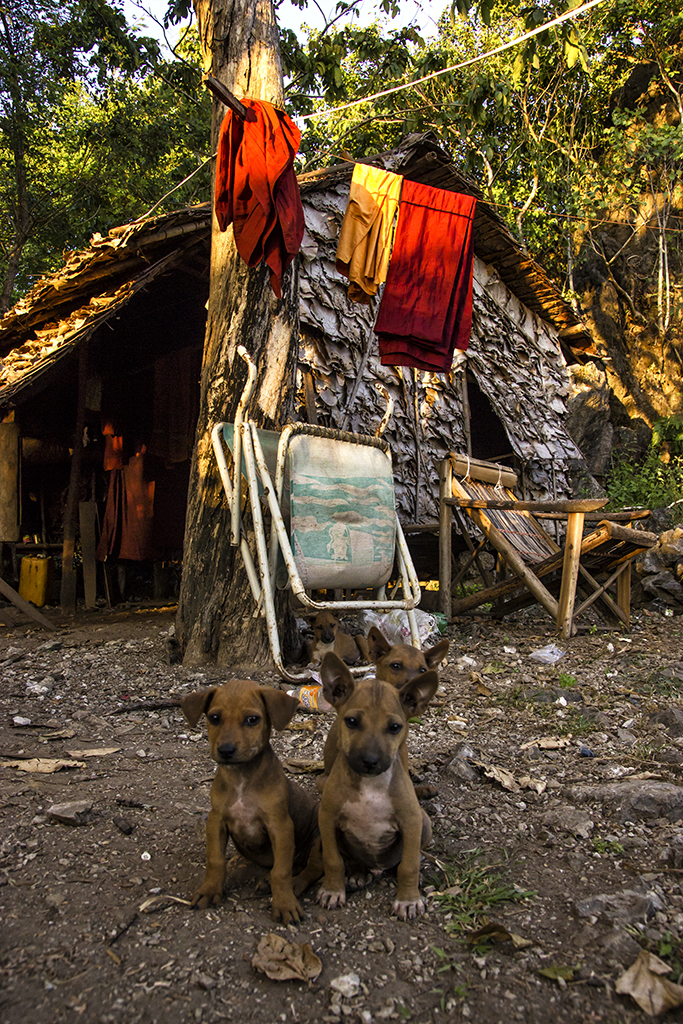
(1/250, F5.6, ISO400, 17mm)
After a dark crossing over the river under the stars, we spent the night with the other handful of backpackers in town and next morning strolled through the old part of town where the villagers were playing Chinlone, the national sport of Myanmar.

(1/60, f5.6, iso400, 20mm)
We met up with our tuktuk driver who would take us on a half-day tour to several sights amidst all the ricefields, steep limestone mountains and wooden shacks. My favorite part was a visit to the Sadan cave with its entrance filled with pagodas and Buddhas including the skinniest I ever saw.

(1/80, f2.8, iso1600, 18mm)
After going past a big reclining Buddha we went through the pitchblack cave to find
a little piece of paradise on the other side.

(1/125, f8, iso100, 17mm)
This boat was going to take us back via an underground river and through the ricefields filled with lilys back to the entrance.
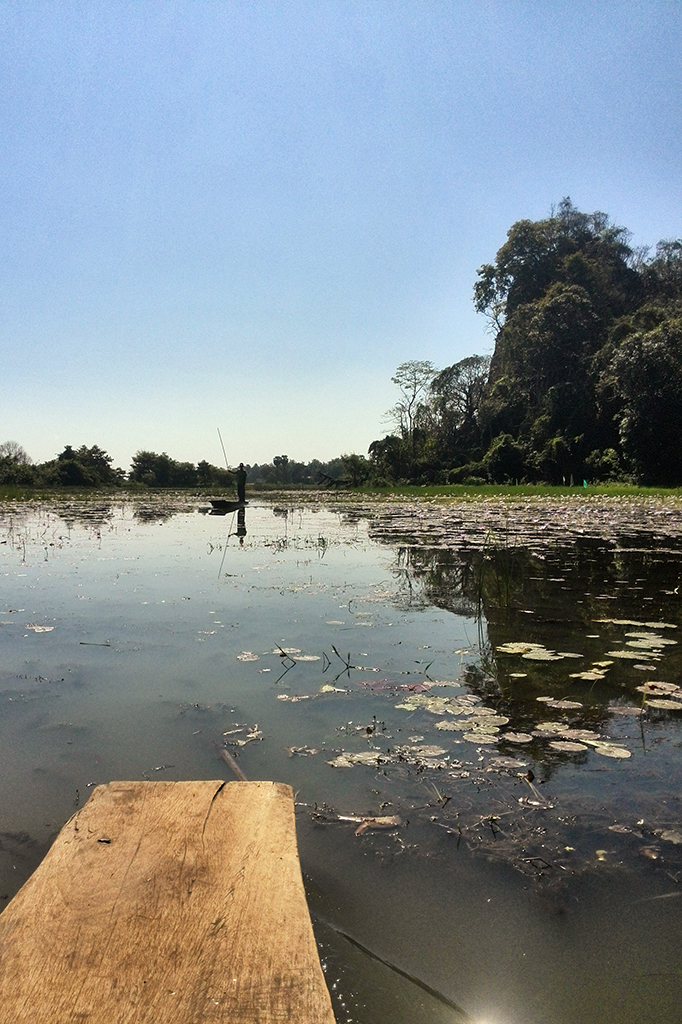
(taken with Huawei P6)
Here you can see a great youtube film about the whole magical experience.
That afternoon we left Hpa-an on the next type of transport: a faster and bigger wooden boat that would take us downstream on the Salween river to Mawlamyine in around 3 hours.

(1/160, f10, iso100, 17mm)
Mawlamyine, also Moulmein, was the first capital of British Burma because of its great location on the Andaman sea and at the Salween river delta and is a charming colonial coastal town.
We got off the boat and went to the only backpackers accommodation in an old colonial building which had a dormitory, small windowless rooms, but also one of the most beautiful rooms I ever slept in with views over the sea, a huge ceiling and countless windows on all sides.
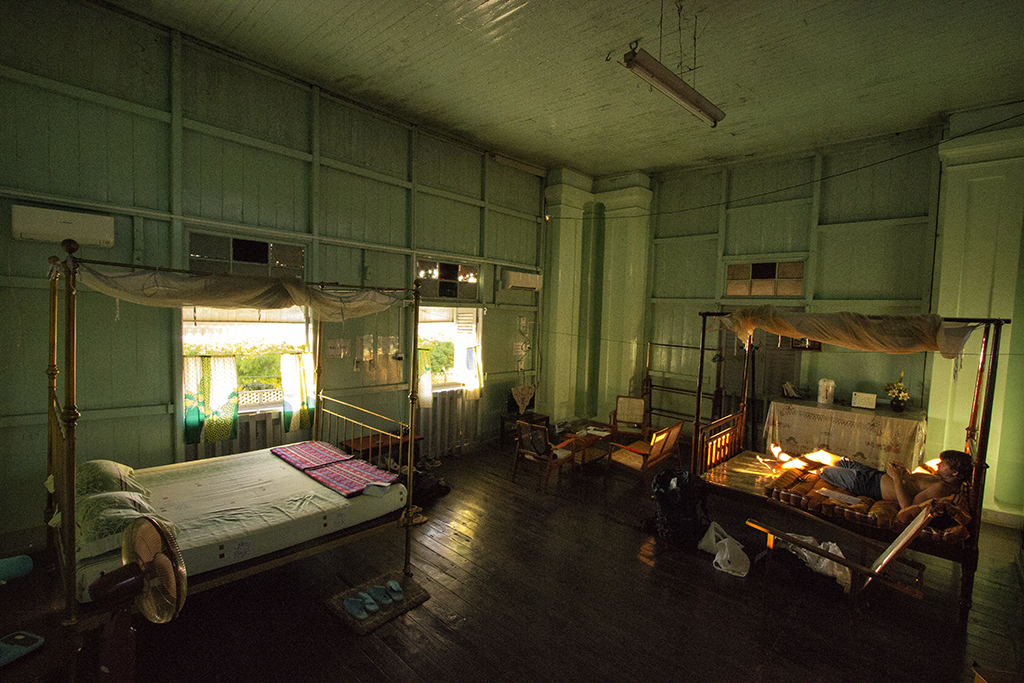
(1/60, f8, iso6400 ,10mm)
After strolling around town and meeting the friendly people we were invited into one of their homes for a Burmese porridge which we shared together (a couple of houses down the left on this photo).
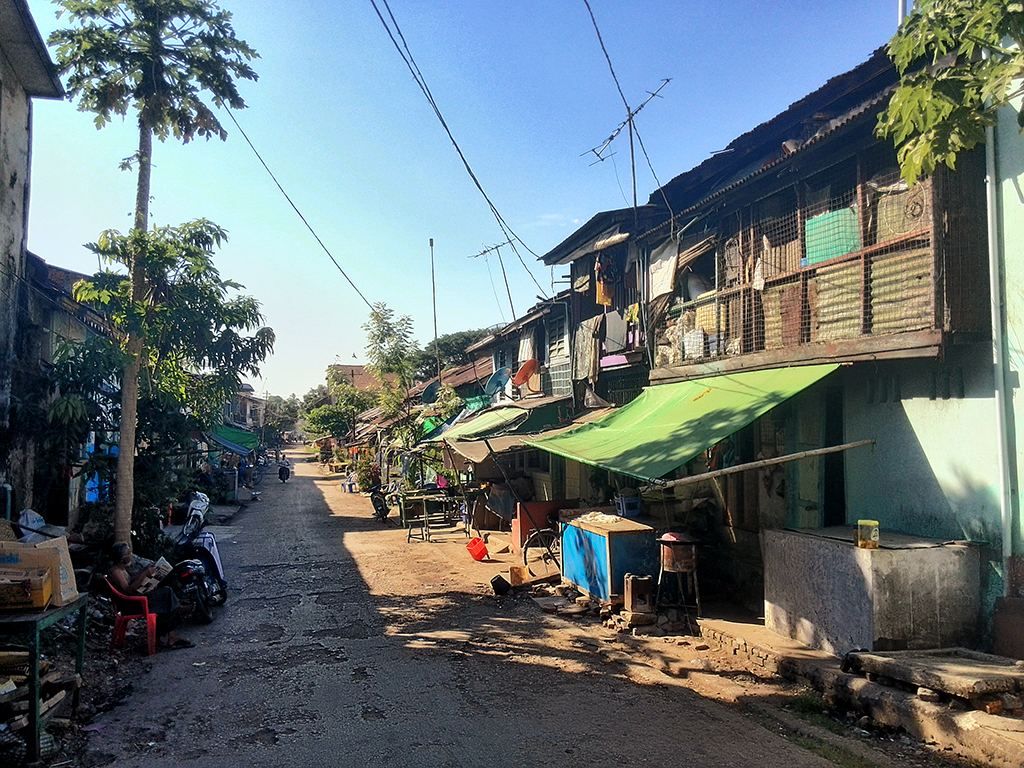
(taken with Huawei P6)
We had a sundown beer on a seaside terrace which was more like the restaurant´s owner own balcony…
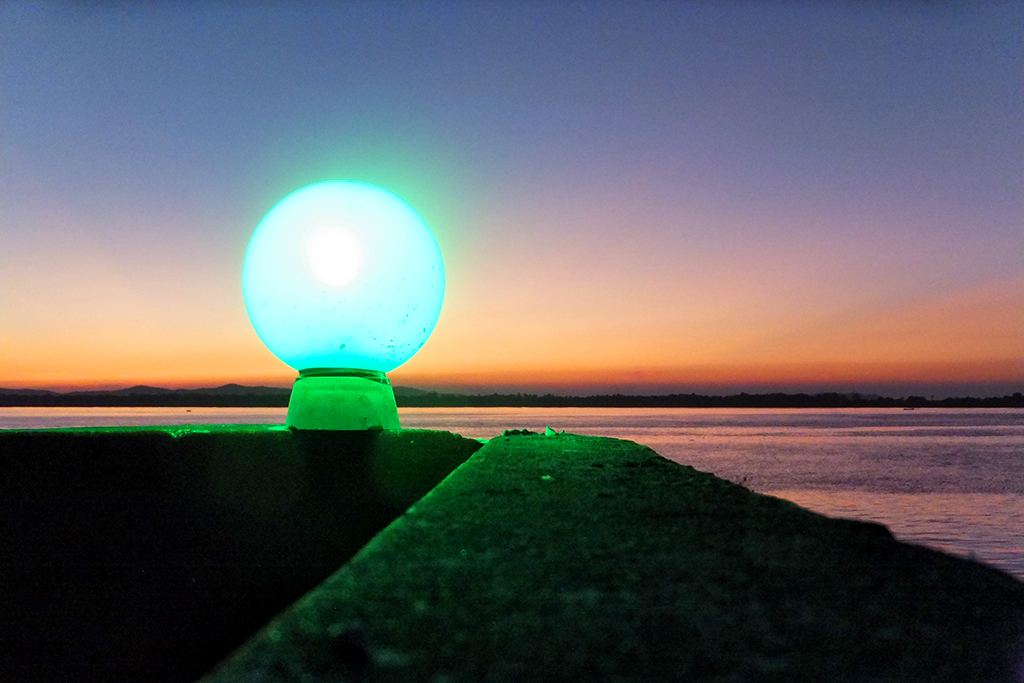
(taken with my friend´s Fujifilm finepix)
…and we ended up on the boulevard where we met up with almost all tourists in town (around 10!) to join the local feast of streetfood that happened there every night. Because we had way too much fun the whole group missed the guesthouse curfew of 11 o´clock(!?!), but the owner opened up, although a little grumpy.
Next day was spent seeing some of the sights around town, like the hilltop temple overlooking the whole town and area, before another sunset drink in great company.
A nightbus took us back to Yangon for the last 24 hours where we filled our day with the stuff we did when we arrived there a week ago, but what felt like much more…
I can recommend everyone to take a different route than the already well-travelled one in Myanmar and experience a country that almost stood still for 50 years.
As I´m off to my home country tomorrow I want to wish everyone a great end of 2016 and enjoy the festivities with your loved ones!
My favorite destination in South East Asia
1. The other side of Myanmar (part 1)
It has been 3 years since I arrived in Kuala Lumpur and my favorite trip so far out of many extraordinary adventures was the spontaneous travel I did with a friend to Myanmar.
All the magazines, articles and blogposts write about the fact you must see Myanmar now before the development sets in.
But all of them talk about going to Yangon, Mandalay, the temples of Bagan and Inle lake, which according to many travelers I met there a year ago and elsewhere around SE Asia, is already firmly on the tourist trail and therefor not for me.
We booked a flight, arranged visas in a day and there we went to Yangon without a proper plan or idea where to go and what to do.
We arrived on friday and decided to spent the afternoon in the old harbour to see all the activity unfold and watch the sun go down over the river…

(1/200, f5.6, iso200, 28mm)
…from a terrace where the locals started there weekend with another pretty good Asian beer, aptly named Myanmar.

(1/125, F54 ISO125, 29mm)
Although my phone camera saw double in the photo above we were doing ok and had some local snacks from a foodstall near the river…

(1/160, f4, iso125, 54mm)
…before we wandered off and took a tuk-tuk to the main attraction in town, the Shwedagon Pagoda.

(1/1250, f2, iso500, 12mm)
Although there were enough tourists, experiencing the candles being lit, the monks making their rounds in prayer while the sun was setting, was magical.
Everything around us was shining bright gold and even the moon decided to make an entrance in between the many small pagodas.
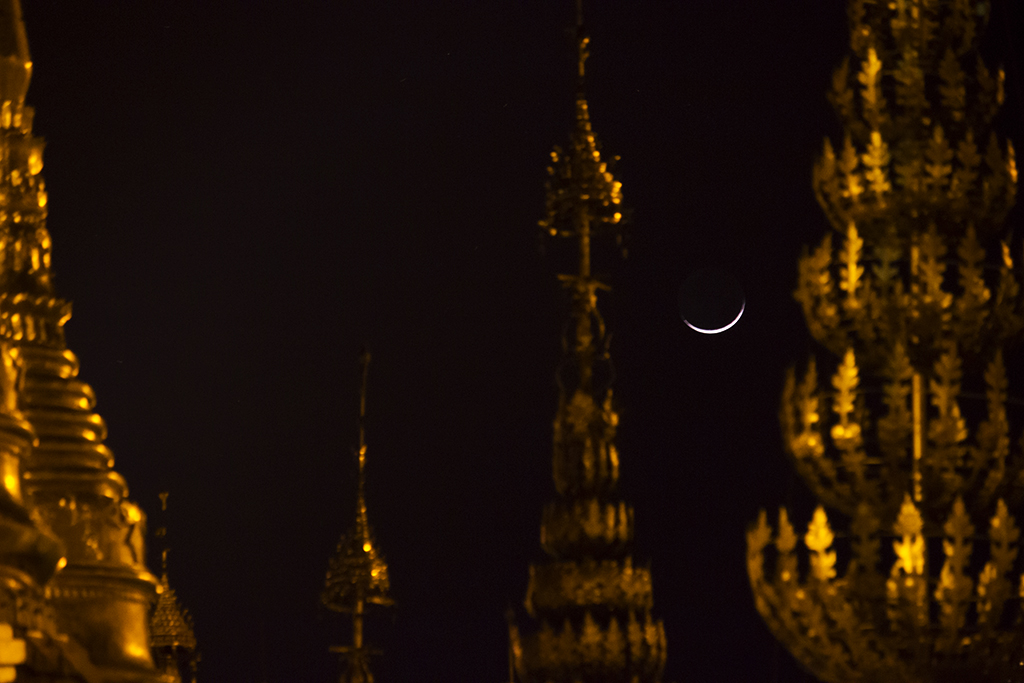
(1/15, f4, iso800, 10mm)
We spent some hours visiting all the surrounding temples and experiencing the atmosphere to the fullest before heading into town to find the famous BBQ-street, where we stayed til closing time at another famous joint, the 80-cent mojito bar Kosan.

(1/640, 4, iso100, 10mm)
Next day we took a long stroll in the old quarter with its dilapitated British colonial buildings.

(1/100, f6.3, iso200, 17mm)
I was interesting to see the people from Yangon and the way they used those old buildings, even making fires inside…
(the bird on the doorstep seems surprised too!)

(1/640, f9, iso200 ,12mm)
After another night strolling around the old centre and ending up in the mojito bar, we took the train to Bago early next morning.
The train took about 2 hours doing the 40km distance, but with that speed it was perfect to watch all the ricefields, pagodas everywhere and locals in their daily routines.
Walking to school…
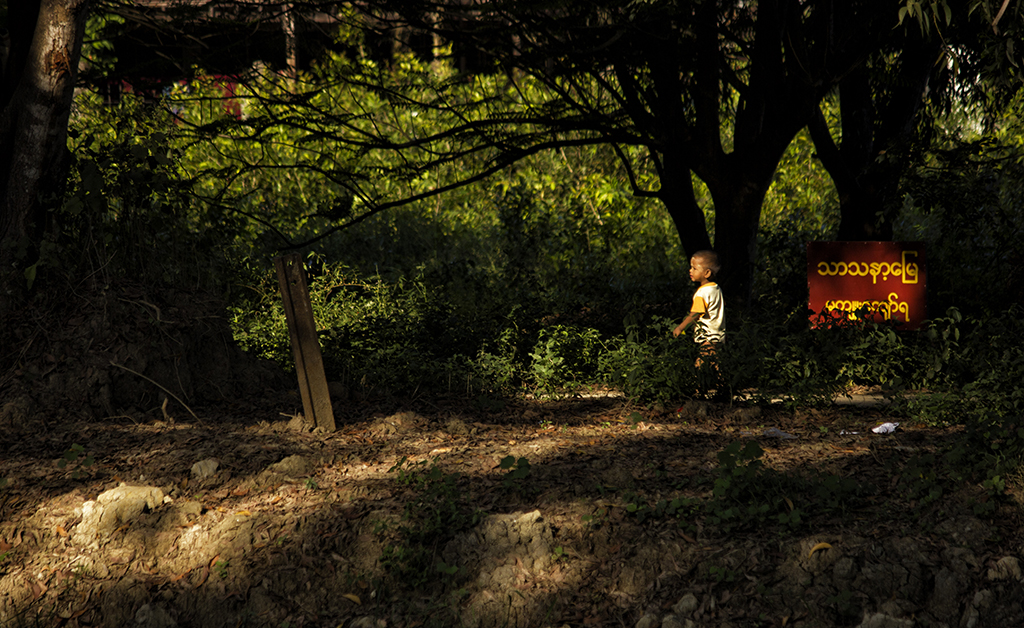
(1/50, f8, iso200, 17mm)
…or commuting to work.
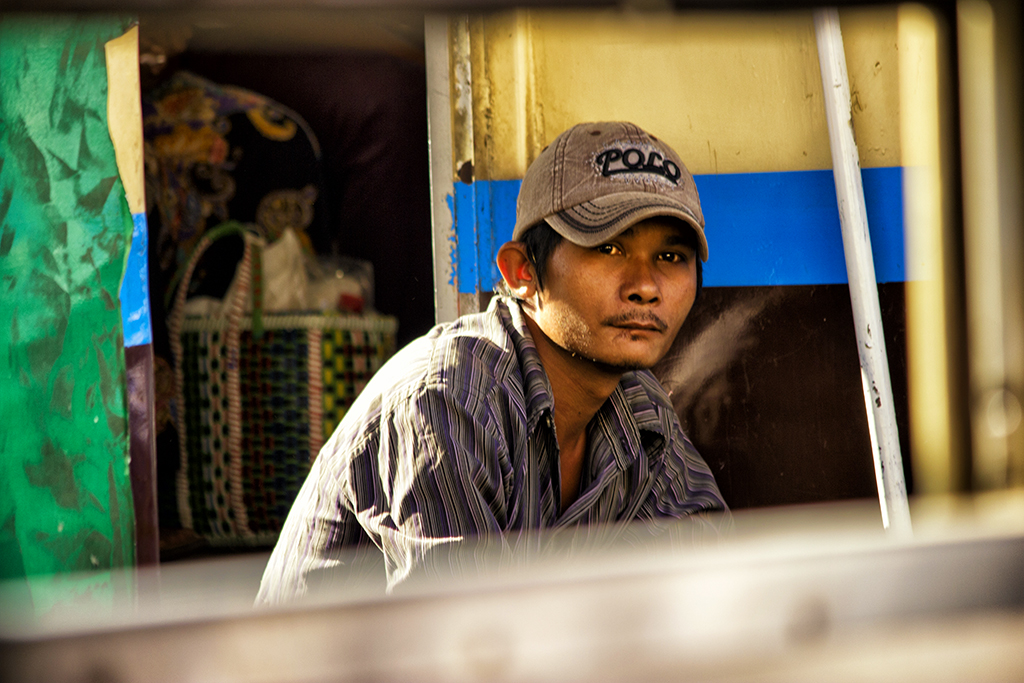
(1/320, f8, iso200, 35mm)
We arrived in Bago, where most people on the train would went to Mandalay, we got off and spent one afternoon biking around the rural landscape visiting many reclining buddhas, monasteries, pagodas and seeing the unbelievably friendly locals waving and (trying) talking to us.
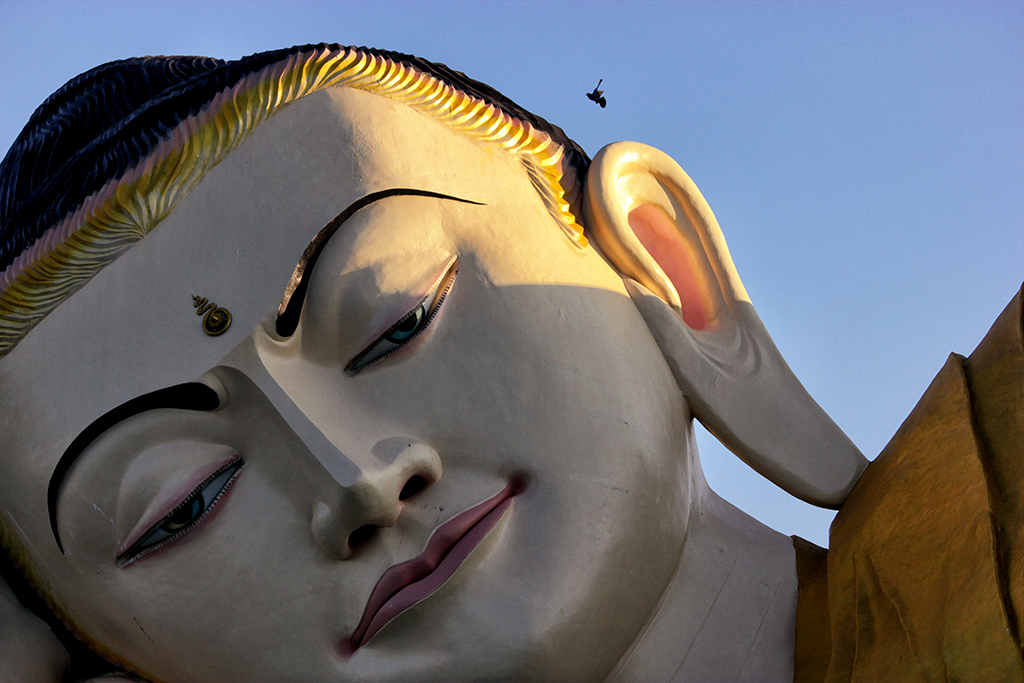
(1/640, f9, iso200, 10mm)
Just before sunset we ended up at the biggest pagoda in Yangon, the Swemawdaw pagoda, which stands even 16 meters taller than the famous Swegadon in Yangon.

(1/640, f6.3, iso400, 34mm)
We talked to an elder man there and watched the bats come out of the pagoda at dawn. The people of Bago protect them and they have a sacred place here.
At that point we were about a 5 km bikeride away from the only guesthouse in town and decided to challenge the Lonely planet´s mention of non-existing nightlife. We biked back and stopped at every place with a beer-sign, which got us into some interesting places. We played some sort of snooker in a wooden shack on the river against betel nut chewing locals and when we arrived at our guesthouse at 5am in the morning our host was anxiously waiting, cuz she didn´t even know it was possible to stay out so late on a monday eve…
I think we won that challenge!
Sorry to say I have to interrupt this broadcast to go on a trip to number 3 on this list and explore some more, but will post the second part when I come back.
Not a cliffhanger, just out of time and I think this post is long enough as it is.
To be continued…
My Top 5 destinations in South East Asia No. 2
2. Nong Khiaw, Laos
Before heading to Nong Khiaw we took an inland flight to the far North of Laos to do some jungle trekking and stay with one of the many hill tribes. On the flight from capital Vientiane to Luang Namtha we saw the impenetrable jungle mountains and rivers we were going to travel back in the next 2 weeks.
A day later we went kayaking into the jungle of Nam Ha National Park and stopped for lunch where some local boys spend their sunday fishing, swimming and enjoying their fire.
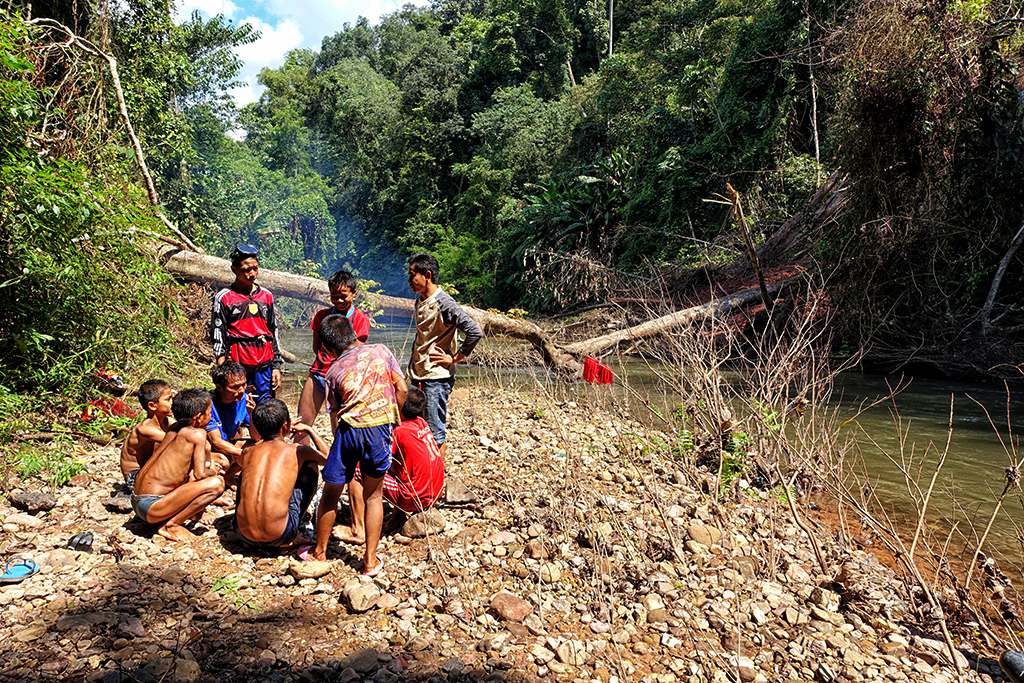
(1/200, f5.6, iso200, 28mm)
We went on and just before dark we arrived at our destination: a small bamboo hut in a hill tribe village. We witnessed the primitive village life of living with animals, farming all day and drinking at night on repeat.
The poverty of these people who still died from malaria, suffered from bad harvests or died because they weren´t able to do the 4-hour jungle hike to ´civilisation´ was another lesson how immensely fortunate lives we live.
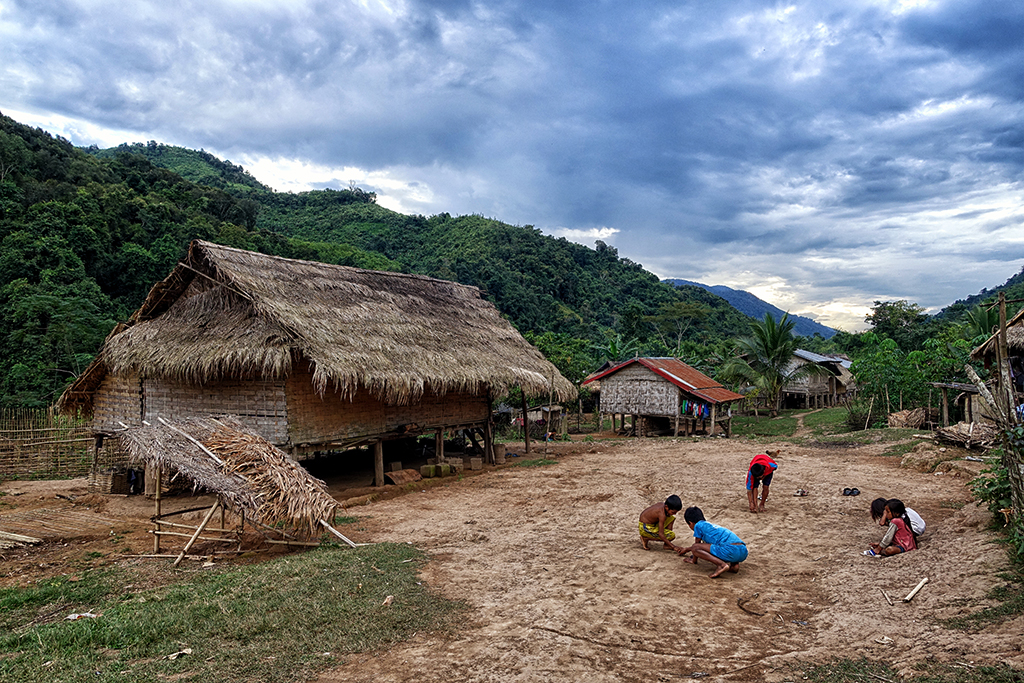
(1/125, F54 ISO125, 29mm)
I was intrigued by all the free roaming animals sharing the space in between the houses.
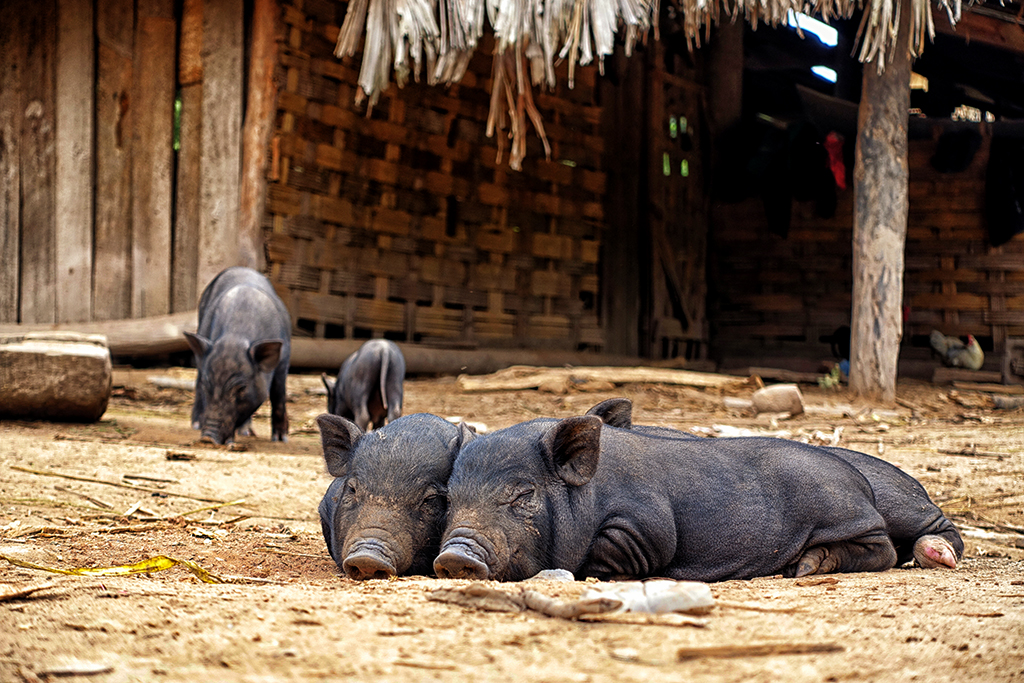
(1/160, f4, iso125, 54mm)
After a half-day jungle hike and a day by minivan through the green mountains of Northern Laos we finally arrived in my second favorite destination in South East Asia, Nong Khiaw.
And to find the northernmost pool in Laos in our guesthouse was a luxury I could not resist.
Also a first on my blog of me in a photo!

(1/1250, f2, iso500, 12mm)
The owner, his wife, the people working there and the amazing bungalows with riverview balcony made the Mandala Ou resort one of my favorite accommodations in Asia.
Next day we explored the area and village by bike and we visited the cave where the villagers hid when the US bombers were flying over, sometimes for months and therefor the huge cave was like a small town with space for a police office, a hospital and stores inside.
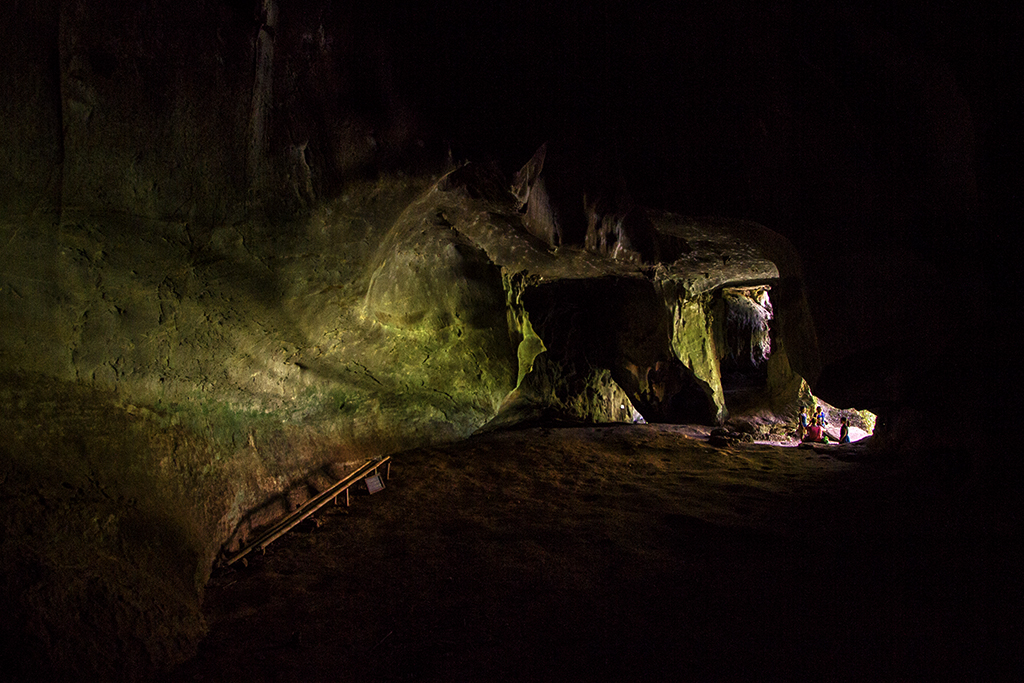
(1/15, f4, iso800, 10mm)
After this depressing sight we sat outside the cave and were enlightened by the pure fun the local kids had jumping, washing and swimming in the river as if nothing ever happened here.
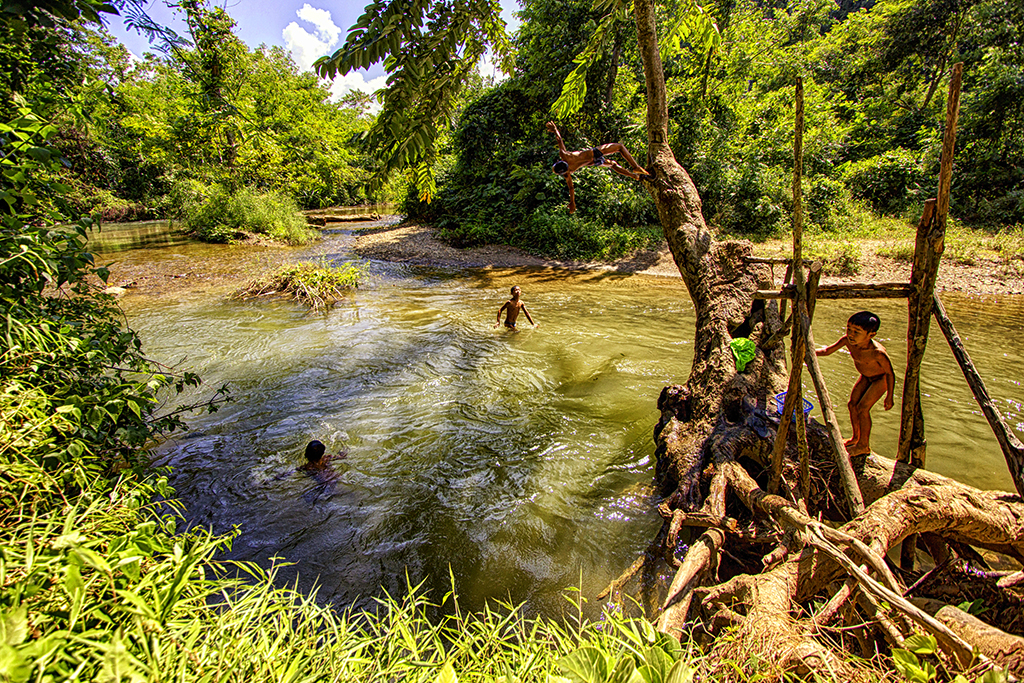
(1/640, 4, iso100, 10mm)
Next day we started early to do an upriver boattrip and this turned out to be the most scenic I´ve done so far.
We departed while the mountains were still covered with mist…

(1/100, f6.3, iso200, 17mm)
…but after an hour the clouds slowly dissappeared and those sheer mountain cliffs showed their grandeur.

(1/640, f9, iso200 ,12mm)
First stop was the one street rivertown called Ban Sop Jam…
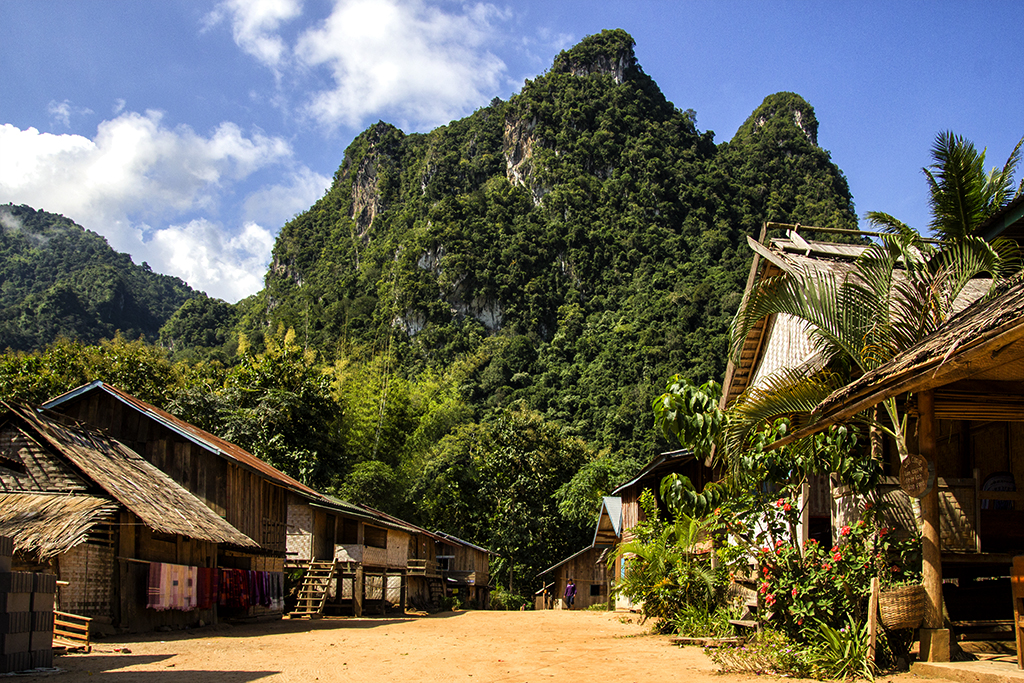
(1/50, f8, iso200, 17mm)
…which is famous for its silk and cotton weaving.

(1/320, f8, iso200, 35mm)
Then another short boatride.
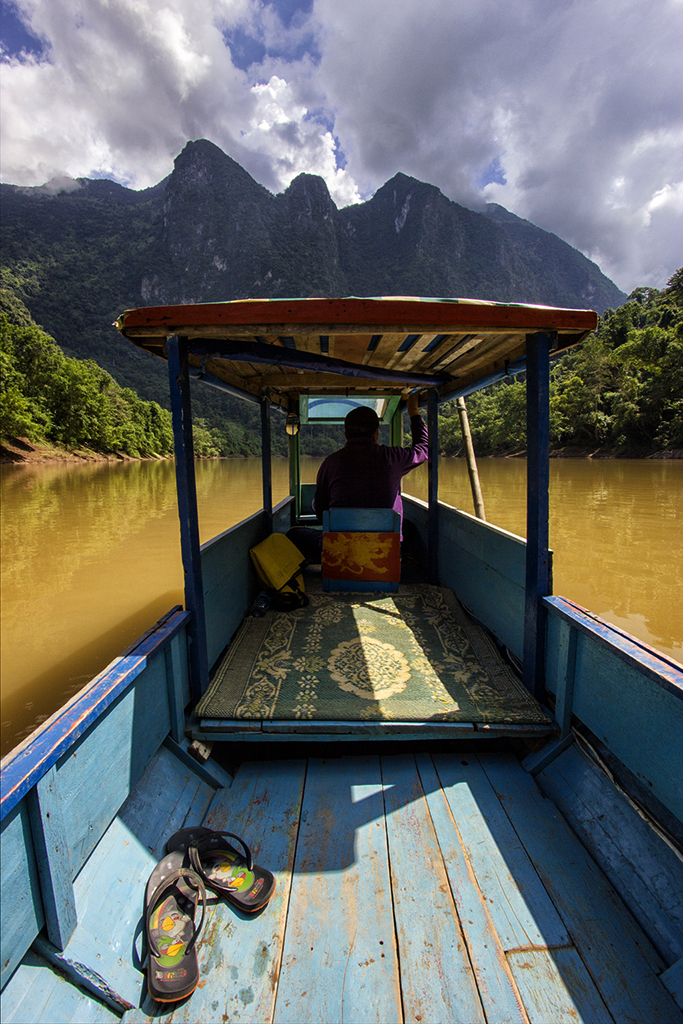
(1/640, f9, iso200, 10mm)
We arrived in the old hippie village Muang Ngoi with majestic views over the river and mountains all around. One of the restaurant owners told us that not more than 20 years ago the wild elephants where still seen bathing in the waters.
After an afternoon of hiking, caving and enjoying the terraces on the water, we went back to the river during sunset.
And all the mountains that were shrouded in clouds in the morning were now covered in golden light…
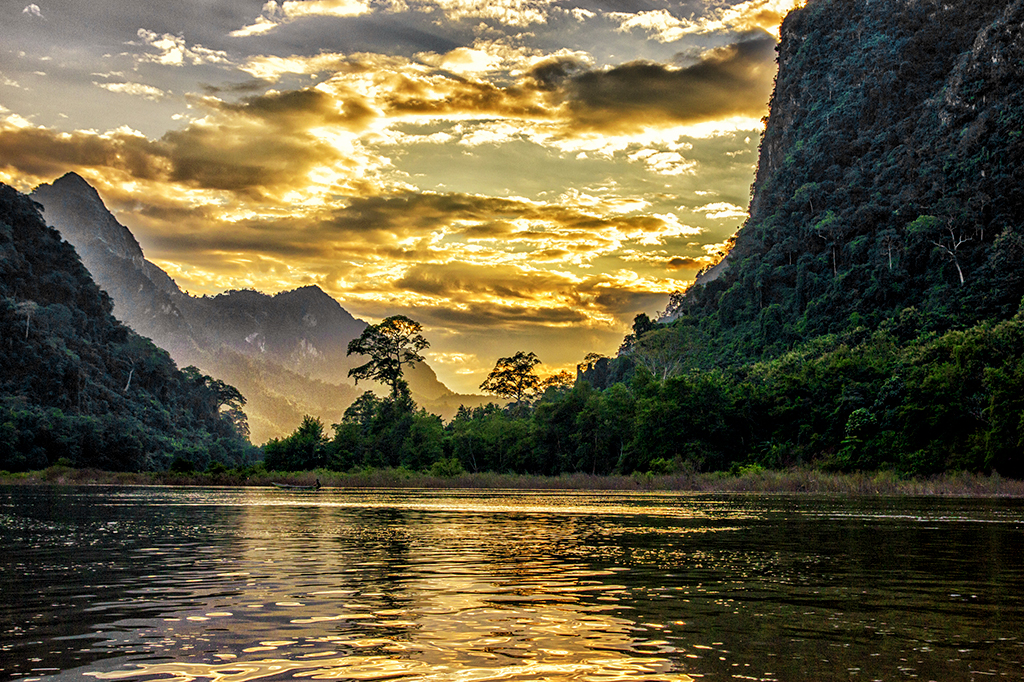
(1/640, f6.3, iso400, 34mm)
When we arrived back in Nong Khiaw we had one look at the river from the bridge and then biked through town back to our pool!

(1/250, f6.3, iso210, 17mm)
I really wish we were able to enjoy this laidback place and its majestic location longer. Especially after another long busride South to Luang Prabang, which is still a great destination but definitely on the tourist trail…
My Top 5 destinations in South East Asia No. 3
3. Krabi town, Thailand
Of all the destinations on this list, Krabi town is by far my most visited.
Being only an hour flight from Kuala Lumpur, this is my favorite getaway.
After visiting this area a dozen times it starts to feel like my second home in South East Asia.
Most visitors will only know Krabi because it is the hub to touristy places like Ao Nang, Koh Phi Phi, Koh Lanta or any of the surrounding islands and beaches, but Krabi town is a perfect base for daytripping and exploring the area.
This is one of them: Tonsai beach on the Railay peninsula, just half an hour longtail boat from Krabi town. This peninsula with beautiful beaches feels like an island, because it is totally cut off by jungle mountains and only reachable by boat.

(taken with my Huawei P6)
Despite Krabi town being a gateway it is very ´Thai´ with only a couple of overnight tourists ready to move on…
I went to most of the popular places and islands around, mainly in rainy season, because it´s more quiet and only means an afternoon downpour or thunderstorm, but they were still too busy, noisy or unfriendly for me.
On the other hand if you go ´off the beaten track´ there are so many daytrips to be made from Krabi town. Most I did on my rental scooter and I even put it on a local boat to the island of Koh Yao Noi, which is surrounded by these limestone mountains rising from the sea, like a quiet Ha Long Bay in Vietnam.
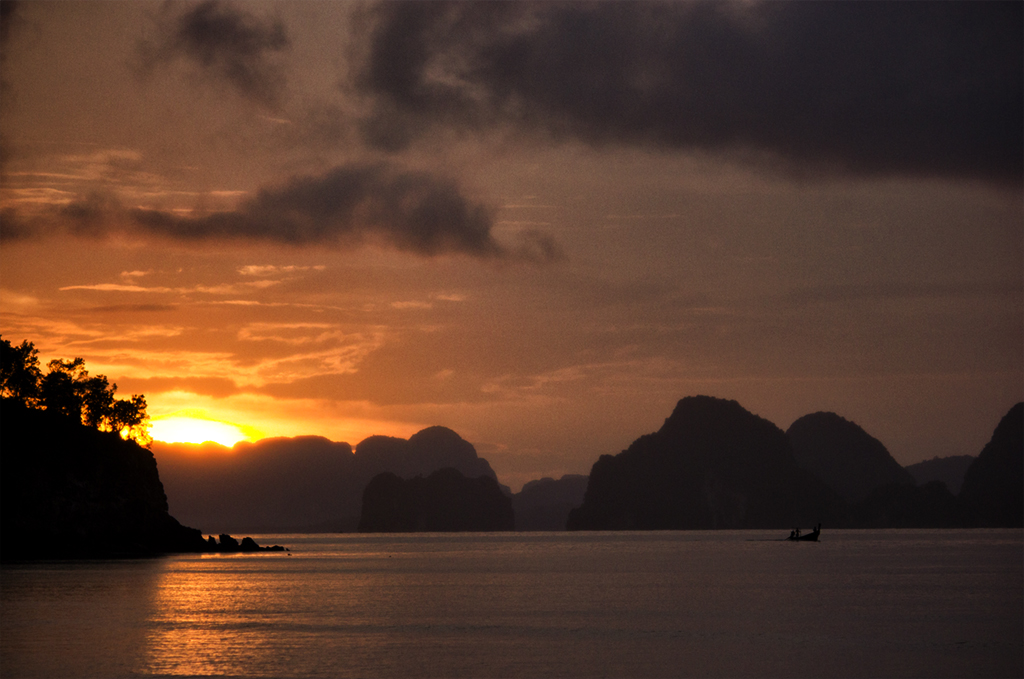
(1/320, F5, ISO400, 109mm)
Koh Yao Noi is hardly visited and most of the 4000 muslim inhabitants live from fishing, rice and rubber farming and are some of the friendliest people I´ve met.
The reason why I love this area so much is that even after all these visits there is still a lot to see and do in the proximity of Krabi town.
Or just exploring the backroads on scooter can be breathtaking.

(taken with Xiaomi Rednote 3)
Last visit I drove to a natural park (30 min. North), where a river flows into the mangrove forest and mixes with the salt water to make these beautiful clear emerald waters.
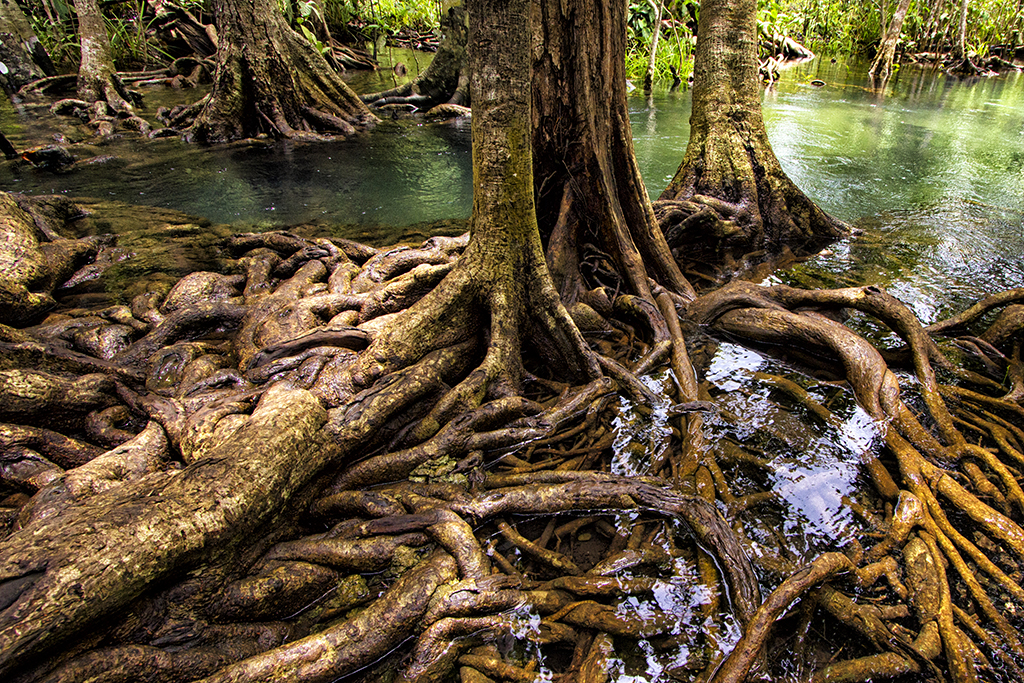
(1/80, f8, iso400, 10mm)
Krabi town itself doesn´t have any beaches, but is located next to a river facing extensive mangrove wetlands, which is another worthwhile (boat)trip.

(taken with Huawei P6)
It is mainly a market town and I´ve never seen a place buzzing with so many markets where the locals sell off their craftwork (at the weekend night market), seafood, meat, vegetables and fruit.
These photos are made around several wet markets.

(1/200, f5.6, iso800, 154mm)
Even the younger family members help out.
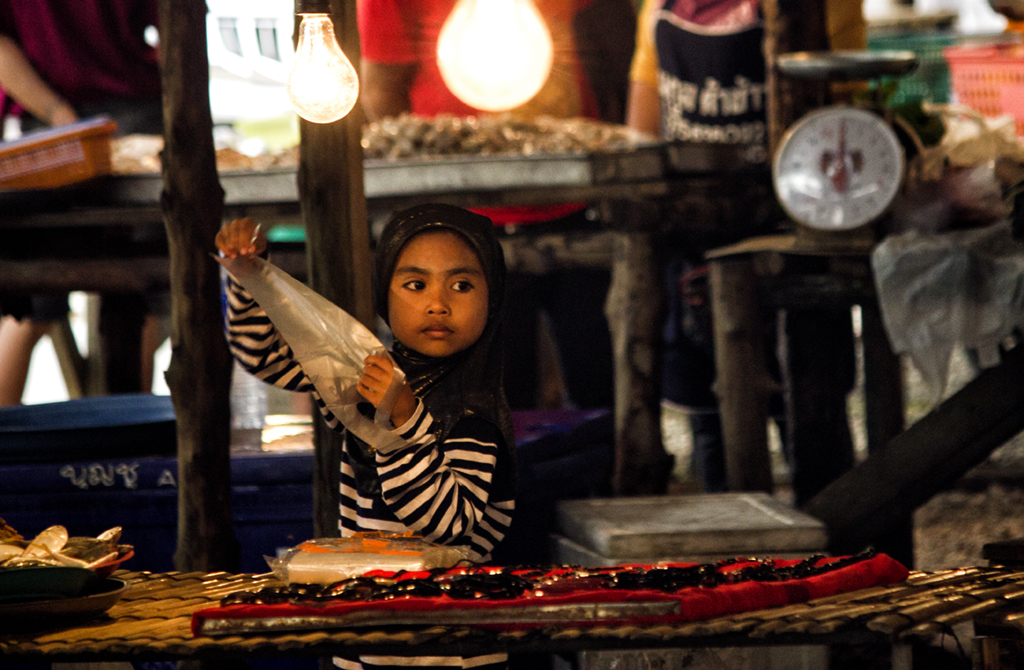
(1/200, f5.6, iso800, 171mm)
Most days I start with a coffee opposite the small but busy daily market in the center of town…
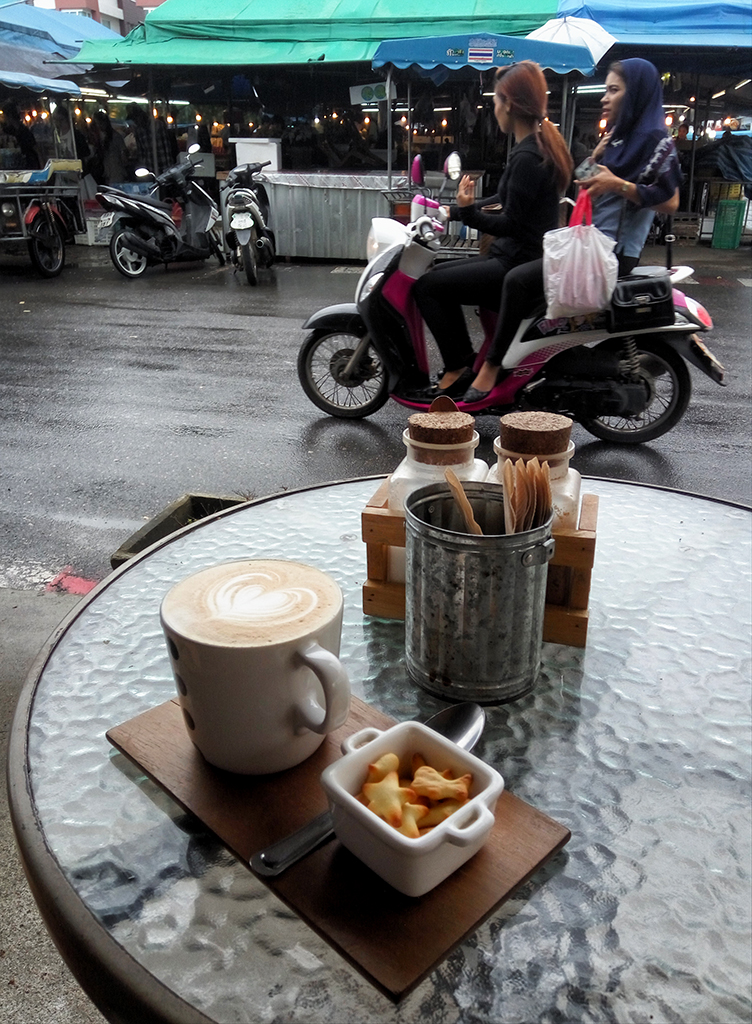
(taken with my Xiaomi Redmi note 3)
And then head out by scooter to explore some remote waterfall, beach, mountains (etc.) or maybe visit some of the familiar faces around the area in their (reggae/ beach)-bars, restaurants or shops. The nice thing about this place is there are many like-minded expats, (some)tourists and locals that prefer to stay here instead of the crowded areas nearby and getting to know them is always interesting.
But whatever made my day I will always end up at the night food market next to the river, where they cook up some of the best (and cheap) Thai dishes I´ve had in Thailand.
This is just after they start up at around 5pm.

(1/100, f2.8, iso200, 58mm)
And this was taken from a bar opposite the market around closing time (around 1am).

(1/1250, f3.1, iso200, 29mm)
I guess I (again) surpassed my longest post ever, but this place has so much to offer and always received me with open arms, that it was hard to contain my enthousiasm.
So for anyone that ever comes through Krabi (town), make sure to enjoy real Thai life and not head to the spoilt places.
My Top 5 destinations in South East Asia No. 4
4. Kampot, Cambodia
It turns out that by coincidence (or not?) this list is counting down to my least touristy experience so far in South East Asia. Georgetown and Kampot are probably the most visited of the 5, but in my opinion the small ´backpacker´ influence doesn´t change the authenticity and connection with local culture. It actually makes them better for it.
Kampot I visited twice, once via minivan from Phnom Penh (4 hours) and the other time coming from the Vietnamese Mekong delta which borders Cambodia at only an hour drive away.
My foremost memory of Kampot is enjoying the views and jumping into the warm waters of the river straight from my balcony.
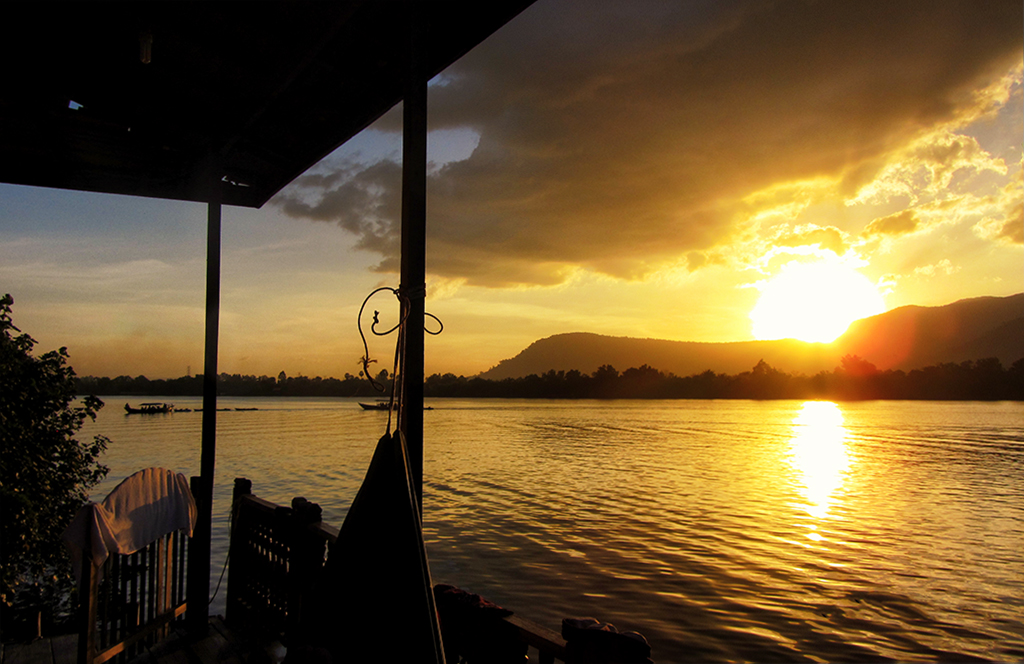
(1/1250, F4, ISO100, 28mm)
Kampot is not far from the sea, but is a river town and although there are some ho(s)tels in town, most accommodation is upriver and many are on the Western banks. My favorite place is on the Eastern side with sunset views over the Bokor Mountain and its surrounding jungle. I was lucky to rent this bungalow with a verandah built on stilts over the water for both times I was there.
The main village is a short scooter or tuktuk ride South and is a tranquil place with pretty French colonial buildings.
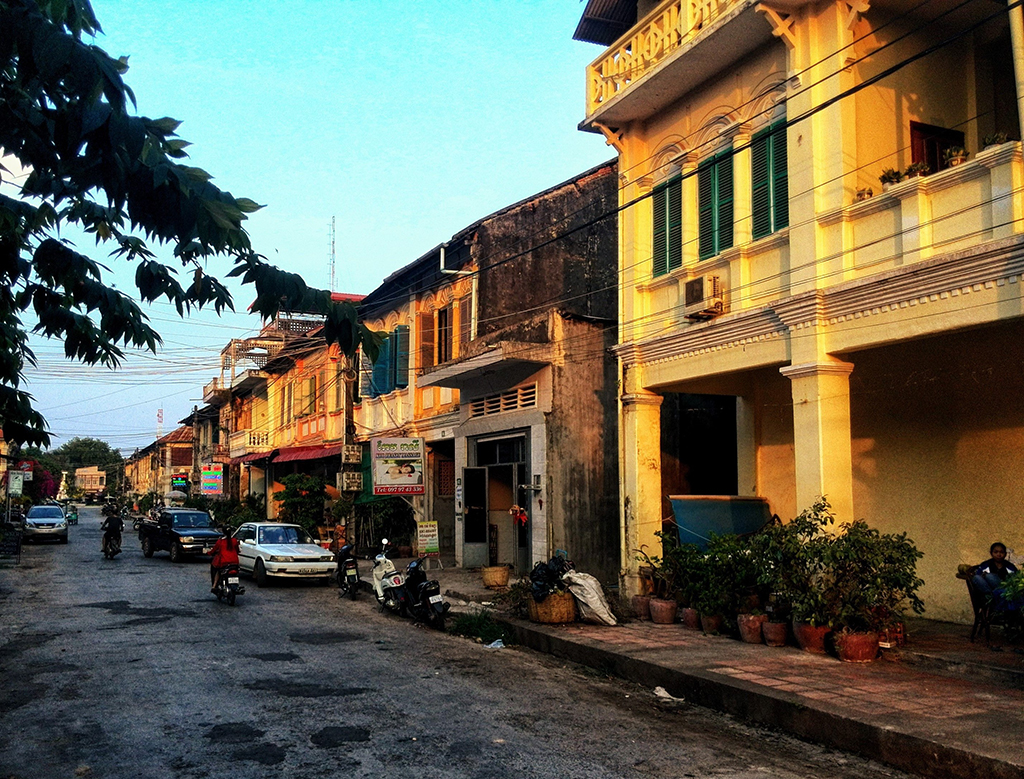
(taken with my Huawei P&)
Wandering around the small centre of town you will find many nice expat-run bars, coffeeshops and local restaurants. Every dish here is decorated with strings of the local Kampot pepper, which is by far the best pepper I´ve ever tasted, and the salt is coming from the salt flats nearby. These combined with all the fresh sea- and riverfood create some extraordinary recipes.
One of the great things about Kampot is the numerous day- or overnight trips you can do from there; you can visit the pepper plantations, the salt flats, the ruins of several old buildings on top of Bokor mountain with views over the vast jungle, which is reputedly a home to elephants and tigers, and the beaches in nearby Kep.
But my favorite getaway would be to drive 20 minutes to crab-village Kep and take a local fisherboat to Koh Tonsay (Rabbit Island) and spent one night there.

(1/100, f7.1, iso200, 28mm)
You´ll arrive at the only beach on the island that has some bungalows with restaurants run by Cambodian families.
We watched the sun go down and ate fresh crab taken from the sea cooked with the famous Kampot pepper.
Electricity goes off at night and when I walked into the sea in the dark I saw the fluorescent plankton for the first time, really something magical!
Next day we went for a hike around the island on hardly existing local paths through jungle, mangrove forests and beaches where local families were farming seaweed. Thinking we could round the whole island in 2 hours we were just blocked by cliffs and jungle at the end.
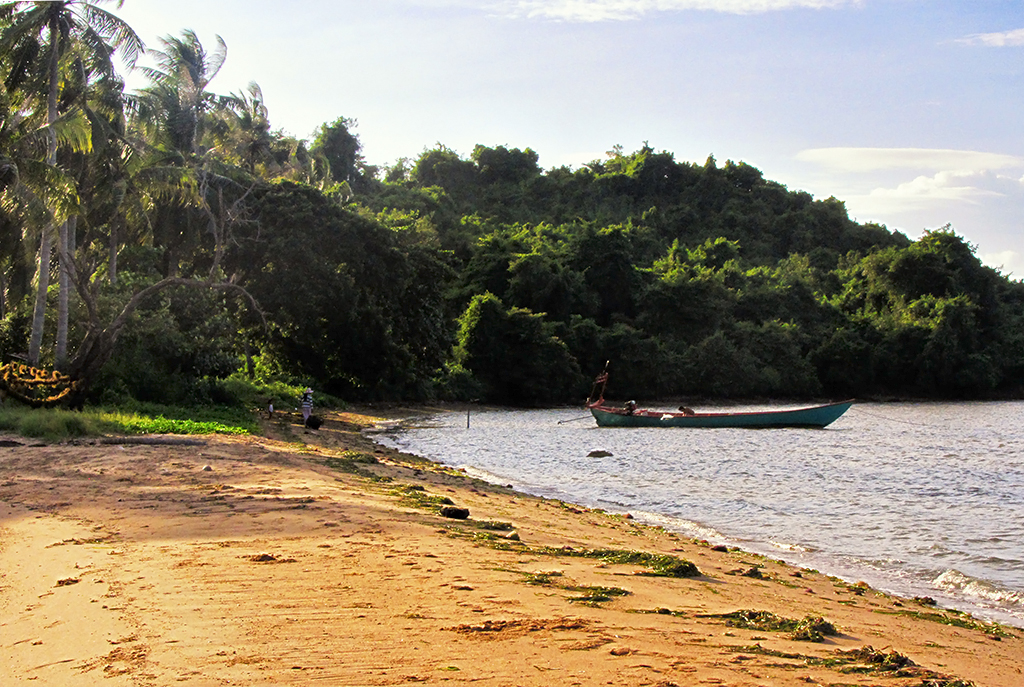
(1/1250, f8, iso200, 56mm)
But the fisherman in the picture was very friendly and took us around the corner and back to the main beach.
One thing that the backpackers community brought to Kampot is some nightlife with a couple of bars in town, but especially lots of live music and late night bars at the resorts on the East banks of the river including some floating rafts for nightswimming.
That night the local Kampot Playboys did rock the house.

(taken with my Huawei P&)
Nothing better than spending the next day on the verandah and the occasional jump in the water to ´cool´ off.
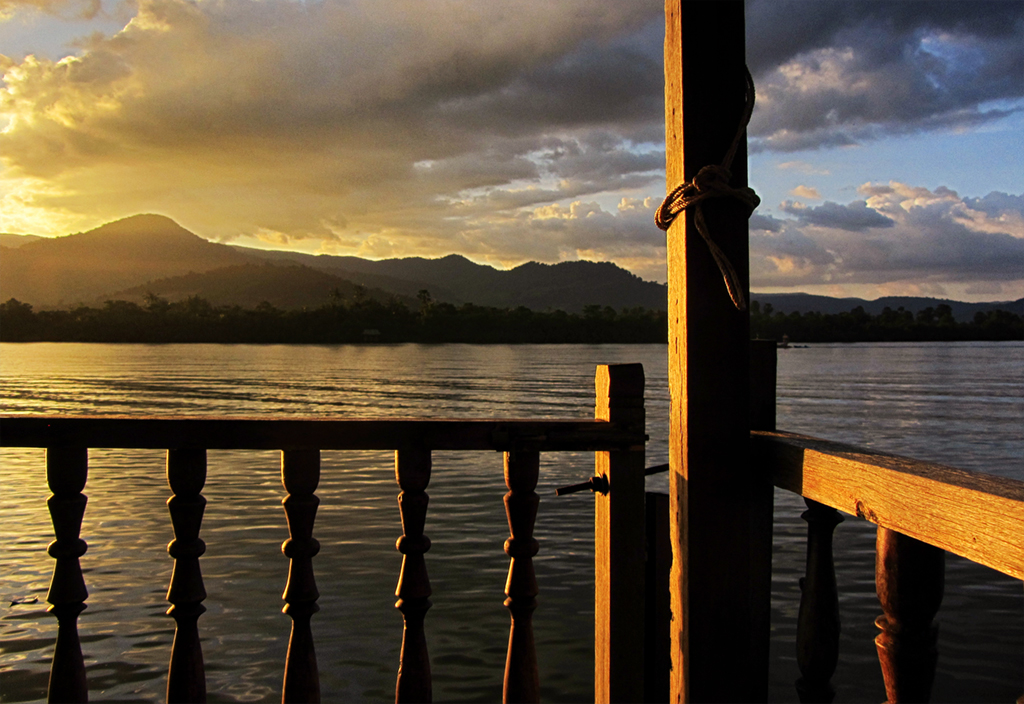
(1/1250, f3.1, iso200, 29mm)
Many people skip Kampot and go straight for Sihanoukville AKA Sinville, but Kampot is the place to be if you ask me….
My Top 5 destinations in South East Asia!
5. Georgetown, Penang
I thought it´s only fair to start the countdown of favorite destinations in South East Asia with my favorite place in Malaysia, the country that treated me so well the last 3 years and Georgetown, Penang, is definitely worthy of a visit.
From Kuala Lumpur to Georgetown can be done by a cheap and short flight or long roadtrip, but my favorite way to get there is by fast and comfortable train through the heart of mainland Malaysia and then hop on a local ferry that drops you in the UNESCO World Heritage centre of town.
The main reason to visit, but definitely not the only one, is the outstanding and diverse (street) food.
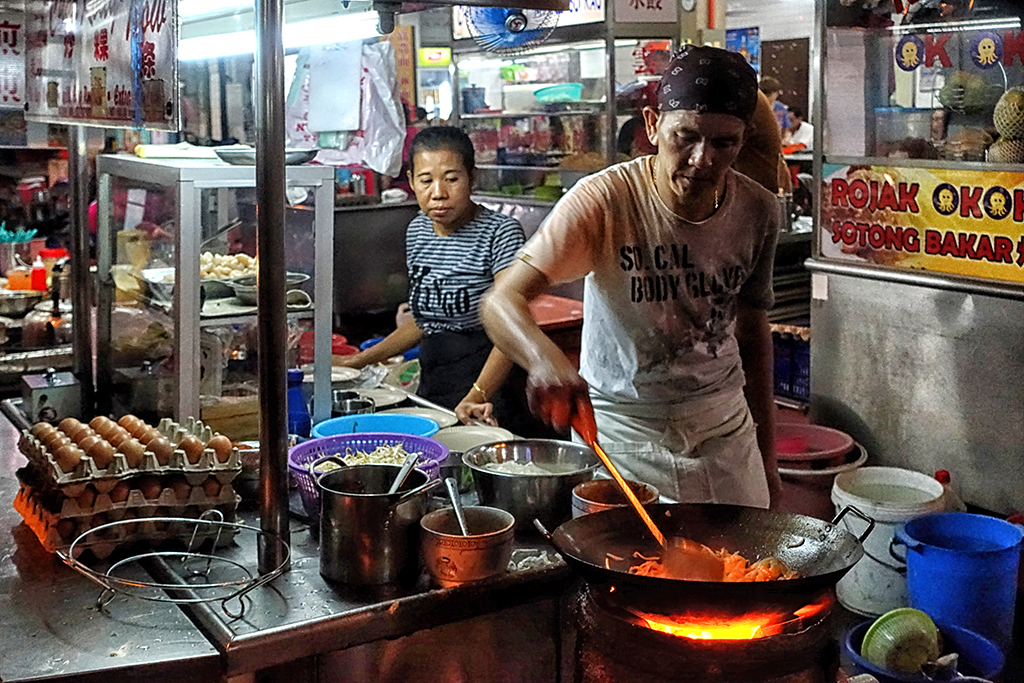
(1/25, F3.2, ISO2500, 16mm)
At night the streets fill up with food stalls where local people have been specializing their recipes for decades. Although I love the food all around South East Asia, the diversity and multicultural history of Georgetown, Penang,
makes it my favorite food destination in South East Asia.
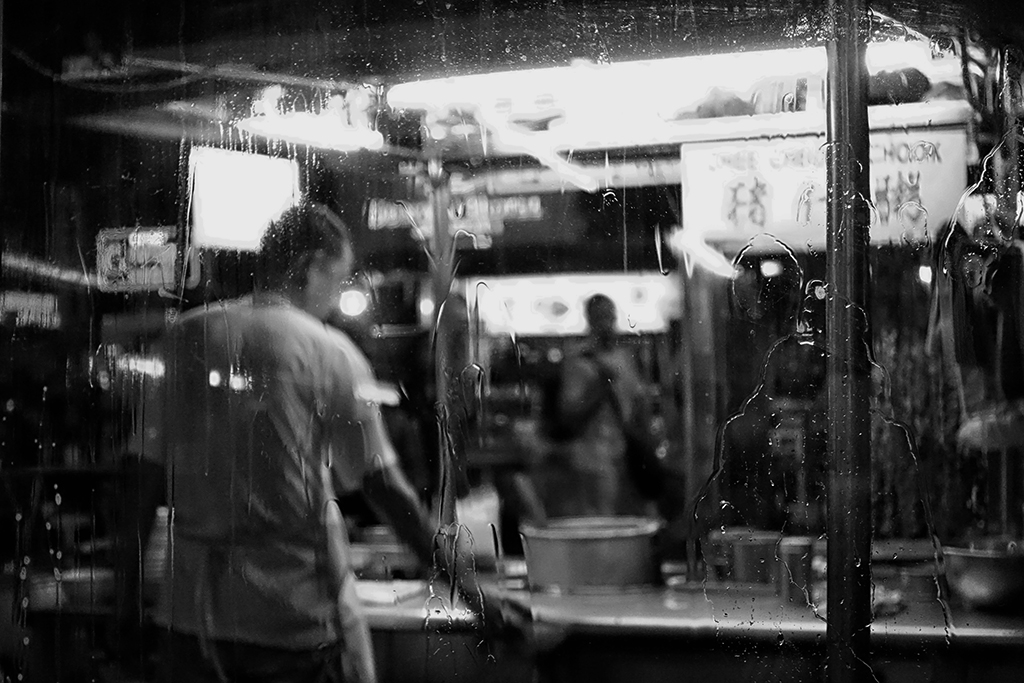
(1/25, F3.2, ISO2500, 26mm)
It is such a pleasure to watch the food stall owners do their magic and take care of their space afterwards with such determination and skill.
Apart from the amazing food, which is available 24/7, the old Chinese shophouses with their shaded arcades and the small alleys make it a perfect place to just wander around.
There are so many old temples, Chinese clan houses and dilapidated houses around the old town that will make you feel like you´ve gone back to the 17th century when the Chinese, Indian, Arabian and European ships harbored here.

(taken with Redmi Note 3)
Many of these old buildings have been turned into galleries, coffeeshops, lunch cafe´s and bars that are perfect places to relax and watch the scenes in front of you unfold…
Next photo is inside the amazing China house which is an old building filled with a restaurant, bars, galleries and a shop.
A great example of how to maintain your heritage and still move forward.

(taken with Redmi Note 3)
Another big attraction are the thousands pieces of street art, big and small, that color the streets and alleys.
Some of the interactive pieces have tourists lined up to take a picture, especially the Lithuanian-born artist Ernest Zacharevic is famous in Malaysia because of his street art.
This is one of his.
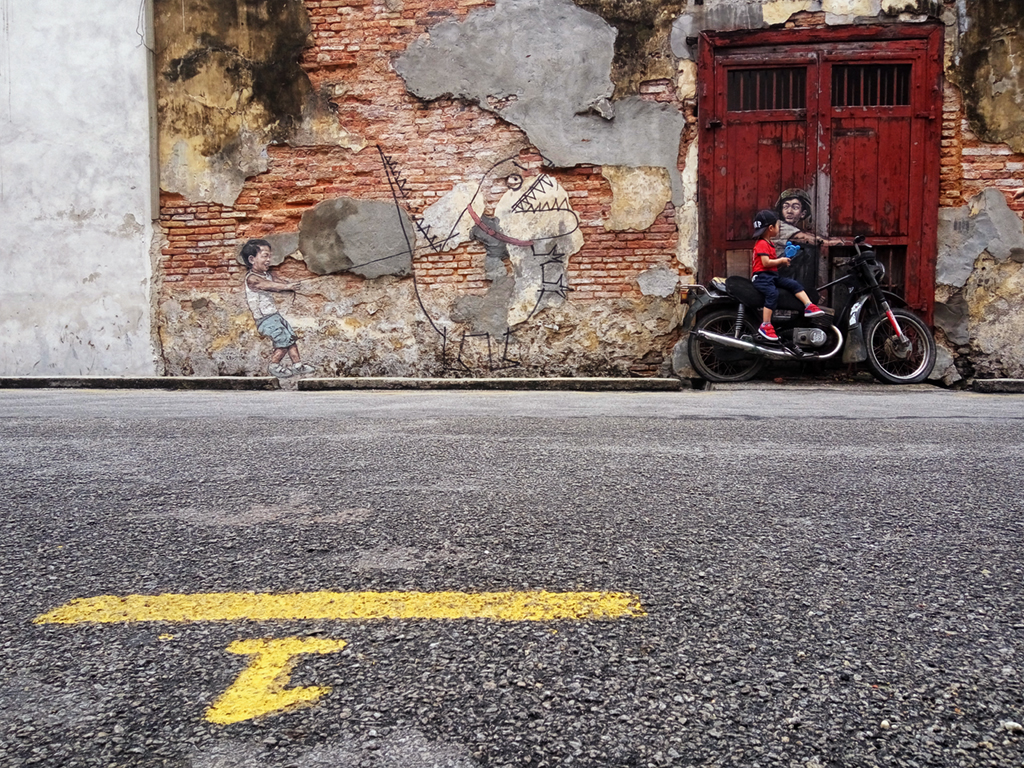
(taken with my Redmi Note 3)
I always like to wander around town and find the lesser known but sometimes even more impressive street art, especially when combined with the crumbling walls.
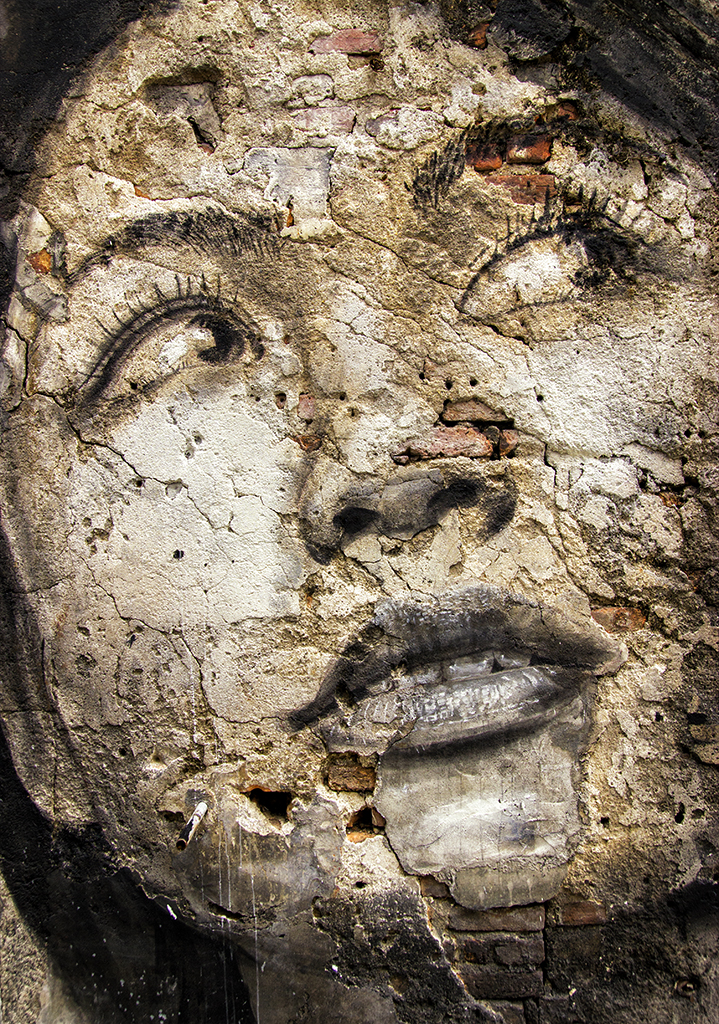
(1/400, f4.5, iso200, 17mm)
And sometimes a friendly old local just fills up the empty part of your frame.
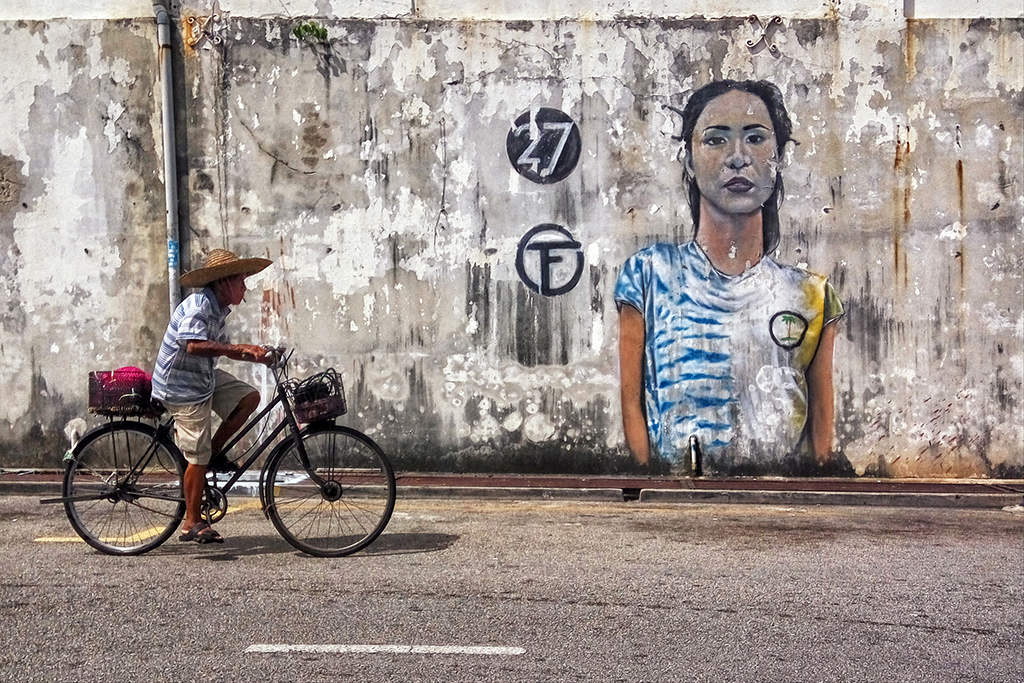
(taken with my Redmi Note 3)
So for me this city is a must-go when in Malaysia and as a token of appreciation for those who made it to the end of the longest post in the history of this blog, here´s the cheapest and most friendly local bar/ terrace/ liquor store in Georgetown:
Antarabangsa Enterprise
Upcoming: top 5 authentic destinations in South East Asia!
It´s about time I put some words and photos to all the travels I´ve been doing the last 3 years, so I decided to make some comprehensive posts about my favorite experiences in South East Asia so far. For the next 5 weeks I will be posting about lesser known destinations I thoroughly enjoyed that didn´t make it unto any lists I´ve seen so far.
These posts will appear every friday for the next month!
To kick things off some photos I made that didn´t appear on my blog yet.
The first was taken on a short boattrip to Rabbit Island in Cambodia. To get there you catch a local fisherman´s boat from the town of Kep and the island itself only exists of a couple of Cambodian families renting out bamboo huts on the beach.

(1/100, F7.1, ISO200, 28mm)
This is definitely one of the places that will be part of the featured travels!
Same goes for the next photo, which was taken on a boattrip on the Nam Ou river in Northern Laos.
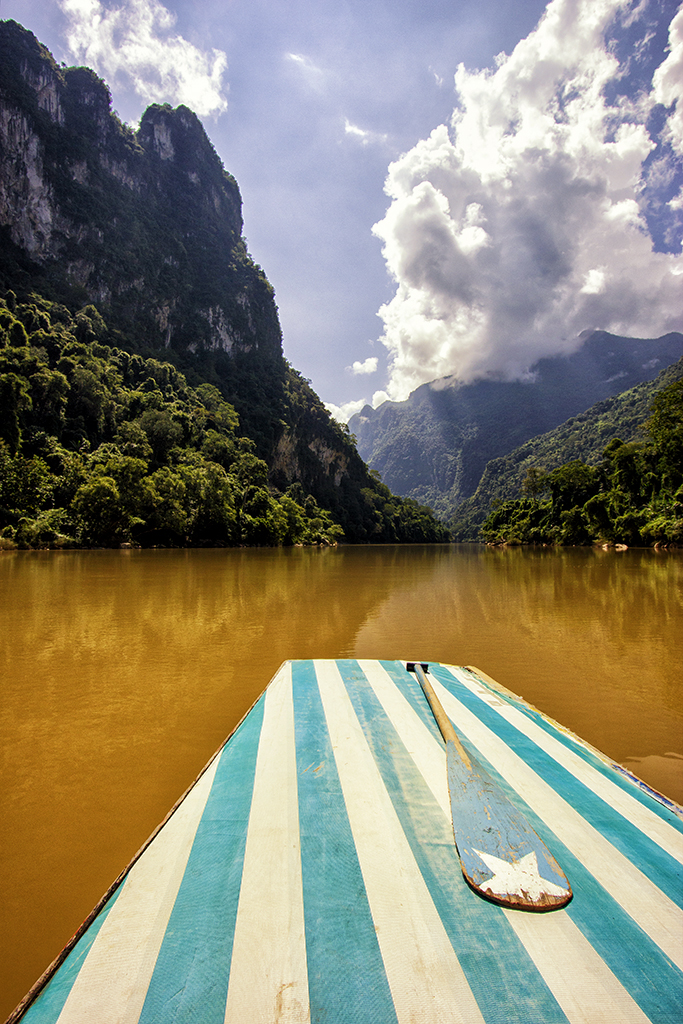
(1/640, F9, ISO200, 12mm)
And to get my least favorite out of the way; the next two were taken last week on a visit to Koh Phi Phi island and although I knew it was going to be touristy, I still wanted to check it out myself and thought that during the rainy season now I had my best chance.
I spent two nights there and although I was more than 2km away from the tourist village the loud beats easily reached my jungle retreat the first night. The second day I was there the King of Thailand died and this threw the whole country in mourning. I was very impressed by the heartfelt emotions shown and spoken by the people I met the week after.
It also meant no parties, no music which meant the second night I was there was very magical and allowed the sounds of the ocean, jungle and night to show the island´s true beauty.
This first photo I took while hiking thru the pristine jungle interior of Koh Phi Phi, which is beautiful with views down to the lesser visited beaches and natural life surrounding me all day.

(taken with Redmi Note 3)
And the worst part was to find some of the beaches that weren´t frequently visited by snorkeling trips to be full of trash and speaking to a local restaurant owner I found out that they can hardly clean up against what the tides bring in every day. This remains a huge problem in South East Asia as plastic and other rubbish is everywhere and unfortunately the waste process is not a priority….
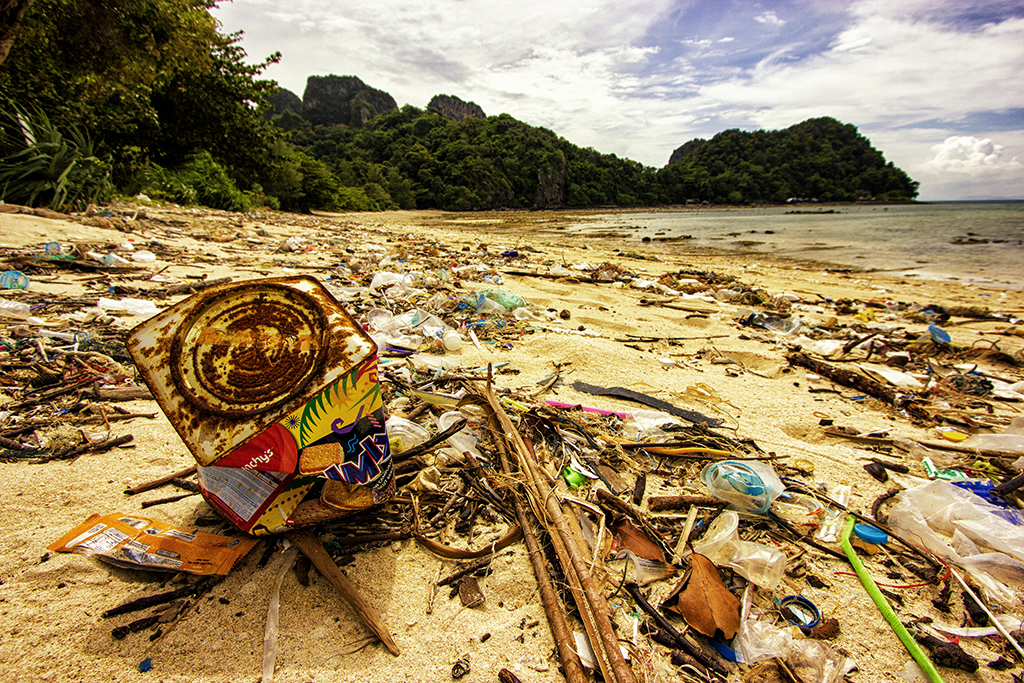
(1/1000, F8, ISO200, 10mm)
From KL with Love

(1/1600, F7.1, ISO200, 74mm)
Too much traveling, no blogging, but I´m still around and will be back. Til then here are some photos from a day spent in KL.
The biggest difference in traveling lately is that the photography is not my priority, the enjoying and experience are most important.
So even though I went to Thailand twice, Tioman island and Holland I hardly made any (worthwile) photos, but the archive is still waiting to be shown…

(1/200, F7.1, ISO400, 10mm)
These were all taken on Ampang hill, East of Kuala Lumpur at an abandoned viewpoint where there used to be restaurants, bars and a club. All these were shut down a couple of years ago due to a landslide.
(1/125, F7.1, ISO400, 50mm)
This last photo is taken a little bit lower on the same hill where the locals started making their amazing local food for ridiculous prices with one of the best views of the sun setting over KL City Centre.
Tomorrow I´m off to Thailand for two weeks and the second half of it will be a bit more about taking photos, so I´ll be back here…
In the meantime my laziness suits Instagram better 😉
Valley of the Rings

(1/500, F8, ISO200, 17mm)
Of all the amazing and diverse landscapes I´ve seen in New Zealand the valleys surrounding Glenorchy was one of my favorites. I can totally understand why film director Peter Jackson thought he could make Lord of the Rings into a movie when his home country has all these epic locations.
These valleys were used in a couple of scenes from his trilogy (depicting Isengard), but before they became known as that, it was mainly an area for mining, first gold and later scheelite, but the last state mines were closed in the 1960´s!
The above photo was taken inside a miner´s cottage.
The next was taken just outside this cabin.

(1/400, F8, ISO100, 17mm)
We stayed in the small town of Glenorchy, which was at the end of the road of an amazing 45 minutes scenic drive from Queenstown which winds past mountains, rivers, forests, glaciers and Lake Wakatipu.
We spent a couple of days exploring the valleys, mountains and waterfalls further up and I tried to make use of some sunsets and sunrises to catch some of the scenery.

(1/400, F8, ISO400, 123m)
Above photo was taken on a piece of land for sale (I wish!) in early morning overlooking Lake Wakatipu. This last photo was shot on the road back to Queenstown, the only way in and out if you are not hiking or flying!

(1/400, F8, ISO400, 123m)
Bye bye Glenorchy, hope to be back someday…
Land of the Long White Cloud
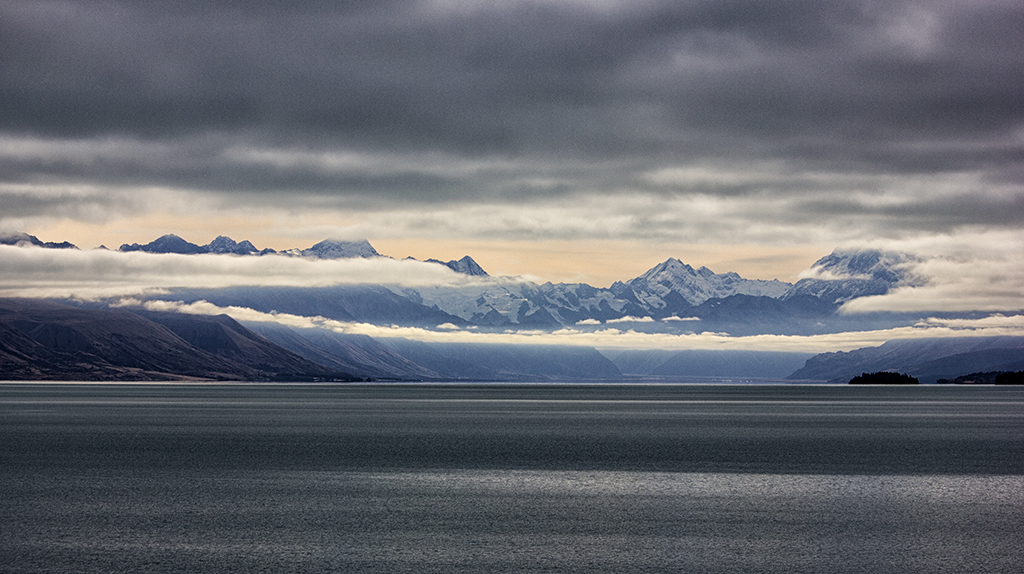
(1/1600, F7.1, ISO200, 74mm)
Just returned from a journey around the South Island of New Zealand or as the Māori called it Land of the Long White Cloud and it seemed appropriate after seeing the above scene on our last day there. It is the view over Lake Pukaki towards Mt. Cook, the biggest on the South Island, but dissappearing in the clouds to the right.
Although my expectations were very high It was easily exceeded by the beauty and diversity of the landscape.
Apart from all its natural beauty the people of the South Island made it even more unforgettable; they were so friendly, interesting and sociable.
Definitely a country where I could live in a heartbeat!
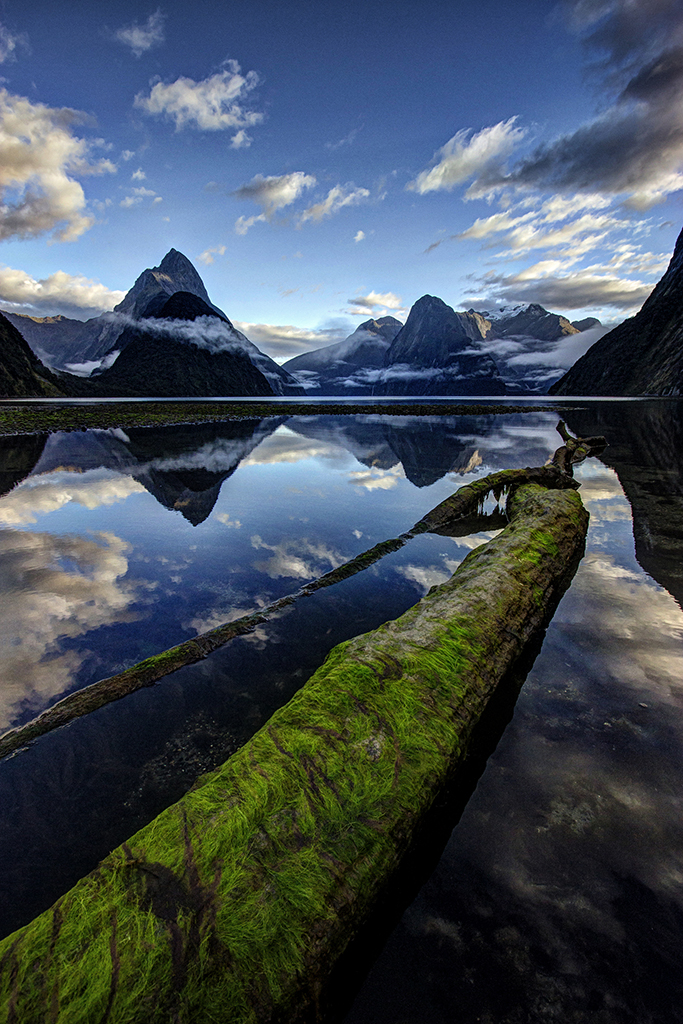
(1/200, F7.1, ISO400, 10mm)
I tried to take advantage of the beautiful autumn light and woke up early to catch sunrises and find pretty spots for sunsets, which wasn´t very difficult, because there is literally magic in every corner of that part of the world.
The above photo and the last were both taken at sunrise in Milford Sound, one of the two magical fjords we saw in the Fjordland National Park.
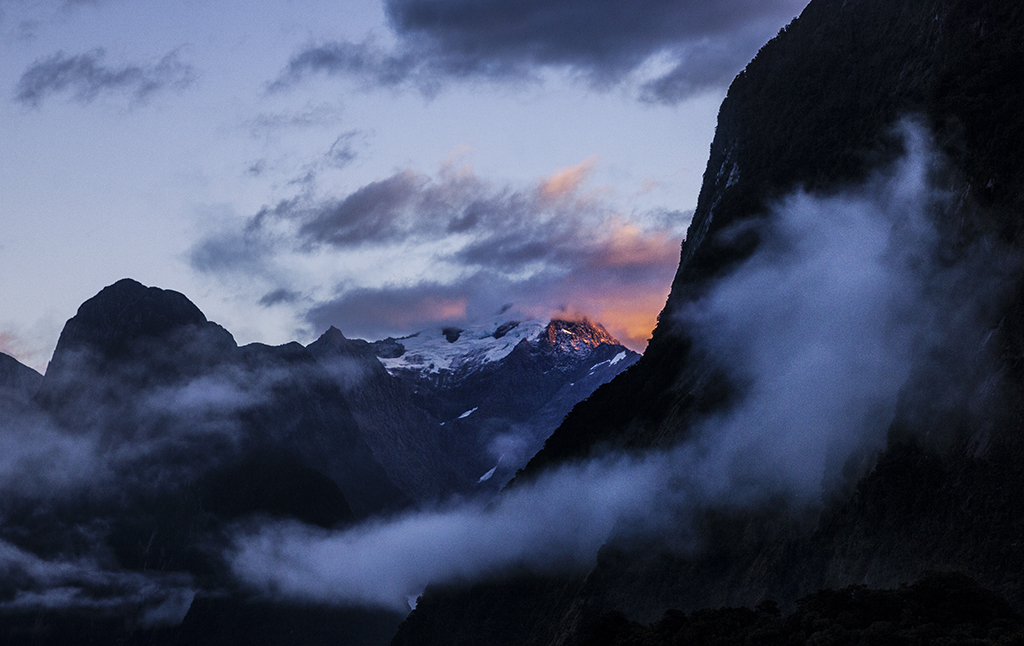
(1/125, F7.1, ISO400, 50mm)
Many more to come…
